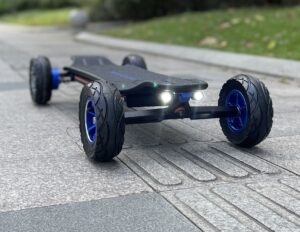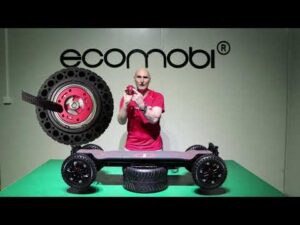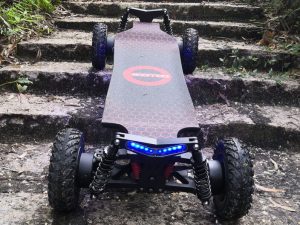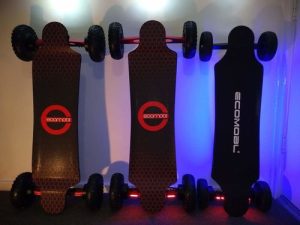Electric skateboards provide a modern twist on a timeless classic. Integrating high-tech batteries and motors into the traditional skateboard design allows these innovative boards to cruise along powered by electricity alone. With just a flip of a switch, you’re effortlessly gliding down the street without breaking a sweat. In this article, we’ll explore the advanced technology within electric skateboards that enables their electrifying ride. From the components that drive their motors to the customizable controls at your fingertips, we’ll cover everything you need to know about how these futuristic boards operate. You’ll gain an appreciation for the ingenious engineering that transforms the iconic skateboard into a sophisticated, self-propelling vehicle.

What Makes an E-Skateboard Electric?
At first glance, e-skateboards look just like your average board with its deck, wheels, and trucks. But crack these babies open, and you’ve got a self-cruising electrified ride. The secret sauce for giving e-skateboards their juice includes lithium-ion batteries, smooth hub motors or belt drives, electronic speed controllers, and handheld remotes.
The rechargeable lithium-ion batteries pack the power to drive the motors. Just plug in and charge up at home! The hub motors or belt drives convert battery power into spinning wheels that propel you along no pushing needed.
The electronic speed controllers regulate acceleration and braking for smooth cruising and slowing. The remotes connect wirelessly, so you can control your speed and hit the brakes with a simple thumbtap.
With their electric superpowers, you can zoom along at 20+ mph without ever kicking, making e-skateboards perfect for commuting, getting in some exercise, or just buzzin’ around town for fun. Feel the wind in your hair as the motors give you that awesome, effortless riding sensation!

How Electric Skateboards Work
Here’s how the magic happens when you pull the throttle:
- The wireless remote signals the electronic speed controller (ESC)
- The ESC activates the battery to send electricity to the motor
- At the motor, electromagnetic forces transform this electrical energy into calibrated rotational force
- This instant torque gets transmitted to the wheels via sleek hub motors or belt drives
- The board accelerates smoothly forward without any pushing needed from the rider
Hub vs. Belt Drive
There are two main motor types used to power electric skateboards:
- Hub motors nestled inside the wheels for a streamlined look. They provide a more direct power transfer but less torque.
- Belt drives use external motors connected by belts to spin the wheels. Belts produce more explosive torque for faster acceleration. But have more moving parts to maintain.
Customizable Control
One exciting feature is how customizable many electric skateboards are. Use remote settings or apps to tweak speed, acceleration, braking, and fine-tune the board to fit your style. Lower speeds for cruising or unlock the full performance potential when ready.
What Are the Key Components of Electric Skateboards?
Now that we’ve covered the general operating principles, let’s take a closer look at the key components that make electric skateboards work:
The Deck
The deck is the board you stand on. E-skateboard decks are traditionally made of maple, bamboo, or carbon fiber. Maple is strong yet flexible, while bamboo absorbs vibration for a smoother ride. Carbon fiber decks are super lightweight but also sturdy. A curved deck helps keep your feet locked in tight.

The Trucks
Trucks connect the deck to the wheels and let you steer. The trucks should be stable at high speeds but also allow sharp turns when needed. Reverse kingpin trucks are very responsive for turning.
The Wheels
For e-skateboards, larger wheels between 70-100mm diameter are best. Bigger wheels roll over cracks and bumps more smoothly. Softer polyurethane around 78-87A grips well but still lets you slide.
The Bearings
High-quality ball bearings let your wheels spin freely with minimal friction. Built-in spacers properly align them and keep out debris.
The Motor
Hub motors in the wheels or belt drive motors are most common. Look for high wattage (500-3000W) for enough power and torque. More watts means faster acceleration.

The Battery
Lithium-ion batteries are high energy and low weight. Higher voltage means more power and speed. Batteries with more milliamp hours (mAh) have a longer range. Charge time is 1-5 hours depending on capacity.
The ESC
The electronic speed controller (ESC) delivers the right power from the battery to the motor. A quality ESC ensures smooth speeding up and slowing down.
Ride Farther with Electric Skateboards
With an electric motor at the helm, e-skateboards free you from pushing and allow you to ride faster and farther than ever before. Whether you’re commuting to work or class, cruising the boardwalk, or exploring nature trails, electric skateboards let you embrace the future – on a ride you know and love from the past. Their space-age tech blended into classic boards makes e-skateboards the perfect vessels to carry surfing sidewalks into the 21st century and beyond!




